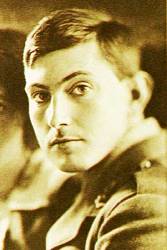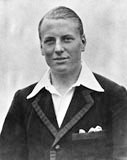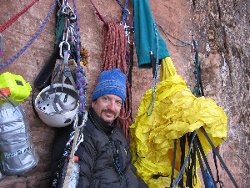
Left: George Mallory and Andrew Irvine © RGS/The Sandy Irvine Trust, from "Ghosts of Everest" ; Right: 1924 North Face locations © Pete Poston
| Photoanalysis | Routes & Maps | Video & Books | Contact Me |


"I'm quite doubtful if I shall be fit enough. But again I wonder if the monsoon will give us a chance. I don't want to get caught, but our three-day scheme from the Chang La will give the monsoon a good chance. We shall be going up again the day after tomorrow. Six days to the top from this camp!"
--from George Mallory's last letter to his wife prior to disappearing on Mt. Everest with his partner Andrew "Sandy" Irvine in 1924
"My face is in perfect agony. Have prepared two oxygen apparatus for our start tomorrow morning".
- Sandy Irvine's last diary entry

Where is Irvine?
© Wim Kohsiek, Oct. 7, 2012
In spite of the efforts of several search expeditions, the body of Irvine has not been found to this day. "The English dead" should be in the vicinity of the 1975 Chinese Camp VI, and the 1999 search was concentrated around the location of this camp as was figured out by Jochen Hemmleb. Later on, the 2001 search expedition found the definitive location of the Chinese camp at a somewhat lower altitude (see Pete Poston’s Website). The 1924 Camp VI was also found by this expedition. Later expeditions were higher on the mountain after reports of “an old dead”, but to no avail.
Mallory was found at about 300 m horizontal distance from their Camp VI , 8120 m, and at about the same altitude. Hereunder I will argue that Mallory and Irvine were descending too low on their way to the camp. It is because of the pressure and temperature drop on the 8th of June, occasioned by the passage of the so-called Western Disturbance.
In an article by Moore et al. (Weather, 2010, Vol. 65, No. 8, pp. 215-218) an analysis is given of the weather situation at that time. The passage of the disturbance caused a significant drop in temperature and pressure. At the 1924 base camp (5029 m) a pressure drop of 9 mbar from 8 to 9 June 0830 local time was recorded. The temperature drop is not that well known since there are no data between 8 and 10 June. I assume for the moment a drop of 10 to 4 oC. What would have been the pressure drop 3000 m higher? Apart from periods of time were there is a considerable atmospheric disturbance, it depends solely on the weight per unit of area of the 3000 m thick air column. It can be shown that a pressure decrease of 1 mbar at base camp leads to a pressure decrease of 0.68 mbar 3000 m higher and an apparent altitude increase of 13.6 m, and a temperature decrease of 1 oC to a pressure decrease of 0.55 mbar and an apparent altitude increase of 10.9 m. Thus, a pressure decrease of 9 mbar leads to 122 m apparent altitude increase, and a temperature drop of 6 oC gives another 65 m, in total thus 187 m.
Mallory (and likely Irvine, too) carried an atmospheric altimeter. It may be assumed that they calibrated the instrument at Camp VI before they left. But thereafter, there was no known reference, except for the summit itself. Even if they succeeded in getting there, and they calibrated, a further pressure and/or temperature drop during the following hours is not at all excluded. However, there is another possibility.
The altimeter found on Mallory’s body showed two rust marks; the hand(s) and crystal were missing. It may be hypothesized that there were two hands, the second being a marker that is hand-set. Mallory may have set the marker when they were on the location of the ice axe, in the morning, as a reference for the down trip. It seems more than coincidental that the rust marks that fits the (shorter) marker is just at this altitude. The other rust mark should then be that of the longer barometer/altimeter hand; it is at an altitude of 7820 m, which seems pointless. It may have moved to that position later, after Mallory’s death.
The marker would have given another reference when, descending, they passed the location of the ice axe. But they could have missed it in the dark and underestimate the pressure drop.
Now, when Mallory and Irvine descended to Camp VI they were too low. Maybe not 187 m, but at least many tens of meters.
But they did not realize. When Mallory fell, and died, Irvine did not know better than that he had not yet reached their camp, and continued descending. Possibly, he passed the camp underneath. How far did he get? Maybe some tens of meters more, till the terrain became too steep and he had to stop, and died.
There is one main problem to this scenario: the rust mark(s) are coupled to the hand(s), but hand(s) and crystal were missing when the altimeter was found.

Articles and Editorials
![]() Harvey V. Lankford, MD, has written a paper documenting the origin of the term "Glacier Lassitude" as a diagnosis for the debilitating effect of altitude as experienced by members of the early British Everest expeditions.
Harvey V. Lankford, MD, has written a paper documenting the origin of the term "Glacier Lassitude" as a diagnosis for the debilitating effect of altitude as experienced by members of the early British Everest expeditions.
![]() My new theory about Mallory and Irvine's last climb, where I believe Odell's sighting was erroneous, and have them taking the Couloir route instead.
My new theory about Mallory and Irvine's last climb, where I believe Odell's sighting was erroneous, and have them taking the Couloir route instead.
Part 1: the ascent
Part 2: the descent
![]() Warwick Pryce is a new researcher who has arrived on the scene, and he has a new theory about how Andrew Irvine could have been the first person to stand on the top of the world.
Warwick Pryce is a new researcher who has arrived on the scene, and he has a new theory about how Andrew Irvine could have been the first person to stand on the top of the world.
Wim Kohsiek has a new interpretation of what Mallory's altimeter can tell us based on scientific applications of meterology.
Mallory and Irvine researcher Wim Kohsiek has two new thought-provoking articles about Mallory's watch and Irvine's location:
Mallory's Watch - Does it Really Point to 12:50 PM?
1924 Oxygen by Richard McQuet and Pete Poston
Why the Camera and Film are not Doomed to Destruction!
The Politics of Mallory and Irvine
Why Andrew Irvine Will Not be Found in a Sleeping Bag! Part 1 and Part 2 on ExplorersWeb
Chomolungma Nirvana: The Routes of Mount Everest
Rust Marks on Mallory's Altimeter
Mystery of Mallory and Irvine's Fate Google Earth Tour - my own ideas in 3-D with audio!
Little Known Free-Solo Ascent of the Second Step in 2001 by Theo Fritsche - I should never have written this - Anker and Houlding deserve credit for the first free ascent
Criticisms of the 2004 EverestNews.com search for Irvine --
The Mystery of Mallory and Irvine's Fate (with J. Hemmleb): Part 1, Part 2, Part 3, Part 4, Part 5.
Mallory and Irvine - Comments on the 'real Second Step' route: Part 1 and Part 2
Conrad Anker's comments on the unlikeliness of a direct route up the prow of the 2nd Step
Articles about my heroes Walter Bonatti and Chris Bonington --
Spilling the Beans - Lino Lacedelli's Book "Price of Conquest: Confessions from the First Ascent of K2" Part 1 and Part 2
The Life and Climbs of Chris Bonington, Part 1, Part 2, Part 3, Part 4, Part 5 final - interview
About Me
 Celebrating my 50th birthday on pitch 3 of Prodigal Son, Zion National Park, Utah
Celebrating my 50th birthday on pitch 3 of Prodigal Son, Zion National Park, Utah
In my free time, I love to photograph and hike the spectacular redrock wilderness of the Colorado Plateau - please visit my Colorado Plateau Homepage.
And for most of my life I've been fascinated with the history, people, and culture of the Himalayas and Karakoram - browse my Mount Everest Trek (1996), Overland Journey from Kathmandu to Lhasa (2000), and K2 Base Camp Trek (2007) webpages.
As for my employment, I work for Western Oregon University where I have been a Professor of Chemistry for the last 20 years. My research interests are in applications of Laser Raman Spectroscopy to such diverse fields as Nanotechnology, Analytical Chemistry, and even a bit of Achaeology through the study of rock art pigments found in the Colorado Plateau. You can access my academic webpage here.

Copyright (c) 2004-2022 Pete Poston. All rights reserved. Visitor's Agreement |